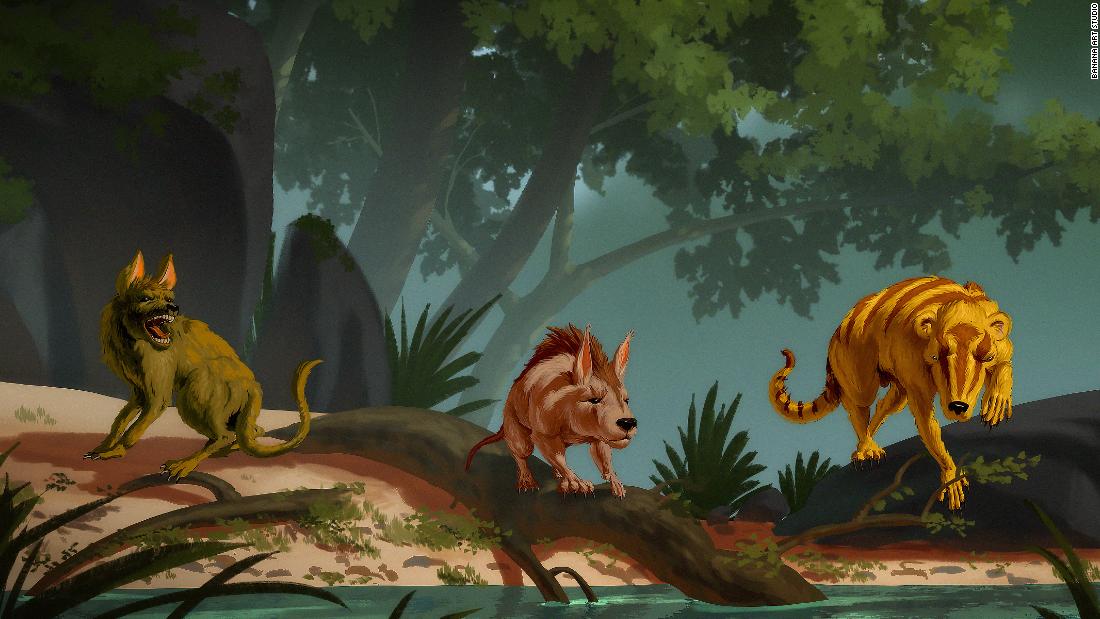
Sign up for CNN's Wonder Theory science newsletter. Explore the universe with news on fascinating discoveries, scientific advancements and more.
(CNN)Three new species of early mammals have been discovered based on fossils found in Wyoming's Great Divide Basin. An analysis of the fossils suggests these creatures rapidly evolved after dinosaurs went extinct about 66 million years ago.
The prehistoric mammals lived in North America a few hundred thousand years after dinosaurs disappeared from the face of the Earth. This is referred to as the early Puercan North American Land Mammal Age, approximately the first 328,000 years after dinosaur extinction.
Paleontologists used lower jaw bones and teeth to reveal more details about the mammals, which were condylarths, the ancestors of modern hoofed mammals like horses, hippos, cows and elephants.
Early mammals that lived alongside the dinosaurs and survived their extinction were quite small, typically ranging from mouse to rat-sized. These newly discovered mammals are a bit larger.
Beornus honeyi, the largest of these mammals, was likely the size of a house cat, and part of its name borrows from the character Beorn from J. R. R. Tolkien's "The Hobbit" because the animal had inflated molars, or puffy cheek teeth. In the novel, Beorn was referred to as a "skin-changer" because he was a man who could take the form of a great black bear and might have sported similar dental features.
The other two species are Miniconus jeanninae, which was similar in size to a ring-tailed cat, and Conacodon hettingeri, which was in between the sizes of Beornus and Miniconus.
The study published Wednesday in the Journal of Systematic Palaeontology.
Unique dental features set these mammals within the Periptychidae family of condylarths, meaning they have vertical enamel ridges and swollen premolars. These teeth would have allowed for an omnivorous lifestyle, helping them chew through meat as well as tough plants, but it's possible they were also simply plant eaters.
The largest molar teeth of Beornus were about 8 millimeters long while Miniconus was distinguished by a tiny cusp on its molars called a parastylid, according to Madelaine Atteberry, lead study author, geologist and undergraduate program assistant in the University of Colorado Boulder Geological Sciences Department.
"When the dinosaurs went extinct, access to different foods and environments enabled mammals to flourish and diversify rapidly in their tooth anatomy and evolve larger body size," Atteberry said. "They clearly took advantage of this opportunity, as we can see from the radiation of new mammal species that took place in a relatively short amount of time following the mass extinction."
The fossils used in this research were collected between 2001 and 2011 in the Great Divide Basin in Wyoming's Red Desert by paleontologists James and Jeannine Honey and Malcolm McKenna. Two of the newly described species' names include nods to the Honey family.
"From this specific locality, they collected approximately 420 mammal fossils — and our paper is only the second to publish a new 'condylarth' species from this collection," Atteberry said. "We hypothesize that there are more new species to be identified from this locality."
Fossils from the Great Divide Basin are contributing to the idea that there was more mammal diversity after the dinosaurs went extinct than expected, and that some of these animals were more evolutionarily advanced than fossils found in other places, according to Jaelyn Eberle, study coauthor, professor of geological sciences at the University of Colorado Boulder and curator in the university's Museum of Natural History.
"Perhaps surprising to me is that we (the greater mammalian paleontology community) kind of thought we had those first few hundred thousand years of the Paleocene figured out -- who the key players were and when they show up in the fossil record," Eberle wrote in an email. "But, I think the locality in the Great Divide Basin is showing us that we haven't fully captured the mammalian story (and diversification) right after dinosaur extinction. The story isn't finished."
The next question the researchers want to explore is why there diversity differs in early mammals across North America in the early Puercan age. This could suggest that some areas, like the Great Divide Basin, have more preserved rock sections than other locations that may be missing parts of the rock record due to erosion. Or it's possible that this diversity was dependent on the environment in which the mammals lived.
"There's a lot we don't fully understand about the mammals that lived in the first few hundred thousand years after dinosaur extinction," Eberle said.
https://ift.tt/3geh5nP
Science
No comments:
Post a Comment